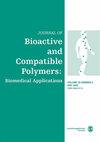聚己内酯-壳聚糖-生物玻璃纳米复合涂层在不锈钢(316L)基体上电泳沉积的研究
IF 2.2
4区 生物学
Q3 BIOTECHNOLOGY & APPLIED MICROBIOLOGY
引用次数: 1
摘要
本研究采用溶胶-凝胶法制备了生物玻璃纳米颗粒,并采用电泳沉积法在SS316L衬底上制备了聚己内酯-壳聚糖-生物玻璃纳米复合涂层。然后,研究了电压和沉积时间对镀层形貌、厚度、粗糙度和润湿性的影响。最后对涂层的生物相容性和毒性进行了评价。结果表明,时间和电压的增加均能提高涂层的厚度、粗糙度和润湿性。同时,沉积时间的增加也增加了结块。因此,可以得出结论,20 V的电压和10 min的时间适合形成均匀的无团块涂层。生物玻璃纳米颗粒的存在也导致了粗糙度的增加和聚己内酯疏水性的改善。结果表明,聚己内酯-壳聚糖-1%生物玻璃纳米复合涂层具有较高的生物活性。样品的粗糙度Ra为1.048±0.037 μm,厚度为2.54±0.14 μm。综上所述,聚己内酯-壳聚糖-生物玻璃纳米复合材料涂层在SS316L基底上是一种提高其体内生物活性和生物相容性的合适表面处理方法。本文章由计算机程序翻译,如有差异,请以英文原文为准。
A study of the electrophoretic deposition of polycaprolactone-chitosan-bioglass nanocomposite coating on stainless steel (316L) substrates
In this research, bioglass nanoparticles were synthesized via sol-gel method and a polycaprolactone-chitosan-bioglass nanocomposite coating was formed on SS316L substrate using electrophoretic deposition method. Then, the effects of voltage and deposition time on morphology, thickness, roughness, and wettability of final coating were investigated. Finally, biocompatibility and toxicity of the coating were evaluated. The results showed that increase of both time and voltage enhanced the thickness, roughness, and wettability of coating. Also, increase of deposition time increased the agglomeration. Therefore, it can be concluded that voltage of 20 V and time of 10 min are suitable for the formation of a uniform agglomerate-free coating. The presence of bioglass nanoparticles also led to the increase of roughness and improvement of polycaprolactone hydrophobicity. The results also showed higher bioactivity in polycaprolactone-chitosan-1% bioglass nanocomposite coating sample. This sample had a roughness (Ra) of 1.048 ± 0.037 μm and thickness of 2.54 ± 0.14 μm. In summary, the results indicated that coating of polycaprolactone-chitosan-bioglass nanocomposite on SS316L substrate could be a suitable surface treatment to increase its in vivo bioactivity and biocompatibility.
求助全文
通过发布文献求助,成功后即可免费获取论文全文。
去求助
来源期刊

Journal of Bioactive and Compatible Polymers
工程技术-材料科学:生物材料
CiteScore
3.50
自引率
0.00%
发文量
27
审稿时长
2 months
期刊介绍:
The use and importance of biomedical polymers, especially in pharmacology, is growing rapidly. The Journal of Bioactive and Compatible Polymers is a fully peer-reviewed scholarly journal that provides biomedical polymer scientists and researchers with new information on important advances in this field. Examples of specific areas of interest to the journal include: polymeric drugs and drug design; polymeric functionalization and structures related to biological activity or compatibility; natural polymer modification to achieve specific biological activity or compatibility; enzyme modelling by polymers; membranes for biological use; liposome stabilization and cell modeling. This journal is a member of the Committee on Publication Ethics (COPE).
 求助内容:
求助内容: 应助结果提醒方式:
应助结果提醒方式:


